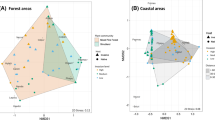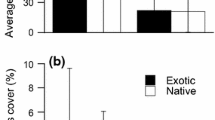Abstract
The ability of an exotic species to establish in a system may depend not only on the invasibility of the native community, but also on its interactions with other exotic species. Though examples of mutually beneficial interactions between exotic species are known, few studies have quantified these effects or identified specific mechanisms. We used the co-invasion of an endangered island ecosystem by exotic Canada geese (Branta canadensis) and nine exotic annual grasses to study the effects of an invading herbivore on the success of invading grasses. On our study islands in southwestern Canada, we found that geese fed selectively on the exotic grasses and avoided native forbs. Counter to current theory suggesting that the grasses should be limited by a selective enemy, however, the grasses increased in proportional abundance under grazing whereas forbs showed declining abundance. Testing potential mechanisms for the effects of grazing on grasses, we found that the grasses produced more stems per area when grazing reduced vegetation height and prevented litter accumulation. Forming dense mats of short stems appeared to be an efficient reproductive and competitive strategy that the Eurasian grasses have evolved in the presence of grazers, conferring a competitive advantage in a system where the native species pool has very few annual grasses and no grazers. Germination trials further demonstrated that selective herbivory by geese enables their dispersal of exotic grass seed between heavily invaded feeding areas and the small islands used for nesting. In summary, the exotic geese facilitated both the local increase and the spatial spread of exotic grasses, which in turn provided the majority of their diet. This unexpected case of positive feedback between exotic species suggests that invasion success may depend on the overall differences between the evolutionary histories of the invaders and the evolutionary history of the native community they enter.



Similar content being viewed by others
References
Banks RC, Cicero C, Dunn JL, Kratter AW, Rasmussen PC, Remsen JV, Rising JD, Stotz DF (2004) Forty-fifth supplement to the American ornithologists’ union check-list of North American birds. Auk 121:985–995
Bellrose FC (1980) Ducks, geese and swans of North America. Stackpole Books, Harrisburg
Bergelson J (1990) Life after death—site preemption by the remains of Poa annua. Ecology 71:2157–2165
Best RJ (2008) Exotic grasses and feces deposition by an exotic herbivore combine to reduce the relative abundance of native forbs. Oecologia. doi: 10.1007/s00442-008-1137-4
Blossey B, Notzold R (1995) Evolution of increased competitive ability in invasive nonindigenous plants: a hypothesis. J Ecol 83:887–889
Buckley YM, Briese DT, Rees M (2003) Demography and management of the invasive plant species Hypericum perforatum. I. Using multi-level mixed-effects models for characterizing growth, survival and fecundity in a long-term data set. J Appl Ecol 40:481–493
Callaway RM, Aschehoug ET (2000) Invasive plants versus their new and old neighbors: a mechanism for exotic invasion. Science 290:521–523
Cargill SM, Jefferies RL (1984) The effects of grazing by lesser snow geese on the vegetation of a sub-arctic salt-marsh. J Appl Ecol 21:669–686
Clausen P, Nolet BA, Fox AD, Klaassen M (2002) Long-distance endozoochorous dispersal of submerged macrophyte seeds by migratory waterbirds in northern Europe: a critical review of possibilities and limitations. Acta Oecol 23:191–203
Colautti RI, Ricciardi A, Grigorovich IA, MacIsaac HJ (2004) Is invasion success explained by the enemy release hypothesis? Ecol Lett 7:721–733
Crosby AW (1986) Ecological imperialism: the biological expansion of Europe. Cambridge University Press, New York
Daehler CC (2001) Darwin’s naturalization hypothesis revisited. Am Nat 158:324–330
Delacour J (1954) Waterfowl of the world. Country Life, London
di Castri F (1973) Climatographical comparisons between Chile and the western coast of North America. In: di Castri F, Mooney HA (eds) Mediterranean type ecosystems, vol 7. Springer, Heidelberg, pp 21–36
DiTomaso JM (2000) Invasive weeds in rangelands: species, impacts, and management. Weed Sci 48:255–265
Falster DS, Westoby M (2003) Plant height and evolutionary games. Trends Ecol Evol 18:337–343
Falster DS, Westoby M (2005) Tradeoffs between height growth rate, stem persistence and maximum height among plant species in a post-fire succession. Oikos 111:57–66
Fox BJ (1987) Species assembly and the evolution of community structure. Evol Ecol 1:201–213
Fuchs MA (2001) Towards a recovery strategy for Garry Oak and associated ecosystems in Canada: ecological assessment and literature review. Technical report GBEI/EC-00-030. Environment Canada, Canadian Wildlife Service, Ladner
Gonzales EK (2008) The effects of herbivory, competition, and disturbance on island meadows. PhD thesis. Department of Forest Sciences, University of British Columbia, Vancouver
Griffin JR (1977) Oak woodland. In: Barbour MG, Major J (eds) Terrestrial vegetation of California. John Wiley, New York, pp 383–416
Gutman M, Noy-Meir I, Pluda D, Seligman N, Rothman S, Sternberg M (2002) Biomass partitioning following defoliation of annual and perennial Mediterranean grasses. Conserv Ecol 5(2):1 (online)
Hanson HC (1997) The giant Canada goose. Southern Illinois University Press, Carbondale
Hierro JL, Maron JL, Callaway RM (2005) A biogeographical approach to plant invasions: the importance of studying exotics in their introduced and native range. J Ecol 93:5–15
Hobbs RJ (2001) Synergisms among habitat fragmentation, livestock grazing, and biotic invasions in southwestern Australia. Conserv Biol 15:1522–1528
Hobbs RJ, Huenneke LF (1992) Disturbance, diversity, and invasion: implications for conservation. Conserv Biol 6:324–337
Hutchinson CS, Seymour GB (1982) Poa annua L. J Ecol 70:887–901
Johnson PG, White DB (1998) Inheritance of flowering pattern among four annual bluegrass (Poa annua L.) genotypes. Crop Sci 38:163–168
Keane RM, Crawley MJ (2002) Exotic plant invasions and the enemy release hypothesis. Trends Ecol Evol 17:164–170
Krebs CJ (1999) Ecological methodology, 2nd edn. Addison Wesley Longman, New York
Levine JM, D’Antonio CM (2003) Forecasting biological invasions with increasing international trade. Conserv Biol 17:322–326
Littell R, Milliken G, Stroup W, Wolfinger R, Schabenberger O (1996) SAS system for mixed models, 2nd edn. SAS Press, Cary
Lush WM (1988) Biology of Poa annua in a temperate zone golf putting green (Agrostis stolonifera Poa annua). 1. The above-ground population. J Appl Ecol 25:977–988
MacDougall AS, Boucher J, Turkington R, Bradfield GE (2006) Patterns of plant invasion along an environmental stress gradient. J Veg Sci 17:47–56
Mack RN, Thompson JN (1982) Evolution in steppe with few large, hoofed mammals. Am Nat 119:757–773
Malo JE, Suarez F (1997) Dispersal mechanism and transcontinental naturalization proneness among Mediterranean herbaceous species. J Biogeogr 24:391–394
Manly BFJ, McDonald LL, Thomas DL, McDonald TL, Erickson WP (2002) Resource selection by animals, 2nd edn. Kluwer, Dordrecht
Mitchell CE, Agrawal AA, Bever JD, Gilbert GS, Hufbauer RA, Klironomos JN, Maron JL, Morris WF, Parker IM, Power AG, Seabloom EW, Torchin ME, Vazquez DP (2006) Biotic interactions and plant invasions. Ecol Lett 9:726–740
Myers JA, Vellend M, Gardescu S, Marks PL (2004) Seed dispersal by white-tailed deer: implications for long-distance dispersal, invasion, and migration of plants in eastern North America. Oecologia 139:35–44
NoyMeir I, Briske DD (1996) Fitness components of grazing-induced population reduction in a dominant annual, Triticum dicoccoides (wild wheat). J Ecol 84:439–448
Pakeman RJ (2004) Consistency of plant species and trait responses to grazing along a productivity gradient: a multi-site analysis. J Ecol 92:893–905
Parker JD, Burkepile DE, Hay ME (2006) Opposing effects of native and exotic herbivores on plant invasions. Science 311:1459–1461
Quigley PE, Ford JZ (2002) Sheep production-system effects on botanical composition and growth of perennial pasture. Wool Tech Sheep Breed 50:477–484
Roemer HL (1972) Forest vegetation and environments on the Saanich peninsula. PhD thesis. University of Victoria, Victoria
Romermann C, Tackenberg O, Poschlod P (2005) How to predict attachment potential of seeds to sheep and cattle coat from simple morphological seed traits. Oikos 110:219–230
SAS Institute (2003) SAS for Windows 9.1.3 service pack 4. SAS Institute, Cary
Schabenberger O, Pierce FJ (2002) Contemporary statistical models for the plant and soil sciences. CRC Press, Boca Raton
Simberloff D (2006) Invasional meltdown 6 years later: important phenomenon, unfortunate metaphor, or both? Ecol Lett 9:912–919
Simberloff D, Von Holle B (1999) Positive interactions of nonindigenous species: invasional meltdown? Biol Invasions 1:21–32
Smith DW (2000) Management of Canada geese in the lower Fraser valley, southwestern British Columbia. In: Dickson KM (ed) Towards conservation of the diversity of Canada geese. Canadian Wildlife Service, Environment Canada, Ottawa, pp 151–158
Smith B, Wilson JB (1996) A consumer’s guide to evenness indices. Oikos 76:70–82
Sorensen AE (1986) Seed dispersal by adhesion. Annu Rev Ecol Syst 17:443–463
Van der Graaf AJ, Stahl J, Bakker JP (2005) Compensatory growth of Festuca rubra after grazing: can migratory herbivores increase their own harvest during staging? Funct Ecol 19:961–969
Van Vliet LJP, Kenney EA, Green AJ (1991) Soils of the Gulf Islands of British Columbia: soils of Sidney, James, Moresby, Portland, and Lesser islands. Report No. 43, vol 5. British Columbia Soil Survey, Research Branch, Agriculture Canada, Ottawa
Vellend M, Knight TM, Drake JM (2006) Antagonistic effects of seed dispersal and herbivory on plant migration. Ecol Lett 9:319–326
Ward P, Radcliffe G, Kirkby J, Illingworth J, Cadrin C (1998) Sensitive ecosystems inventory: east Vancouver Island and Gulf Islands, 1993–1997: methodology, ecological descriptions and results, vol 1. Canadian Wildlife Service, Pacific and Yukon Region, Victoria
Whitson TD, Koch DW (1998) Control of downy brome (Bromus tectorum) with herbicides and perennial grass competition. Weed Technol 12:391–396
Williamson M (1996) Biological invasions. Chapman & Hall, New York
Acknowledgments
We thank D.S. Srivastava, M. Vellend, R. Guy, L.B. Marczak, the Arcese lab, the UBC Florum discussion group, J. Hille Ris Lambers, and one anonymous reviewer for helpful comments, and M. Flint for field assistance. We thank the Gulf Islands National Park Reserve and, especially, A.J. Brumbaum and W. and H. Hesse for their very generous contributions to our research. R.J. Best was funded by a Julie-Payette NSERC Research Award and by the UBC Faculty of Forestry. All research reported herein complies with current Canadian law.
Author information
Authors and Affiliations
Corresponding author
Additional information
Communicated by Miguel Franco.
Electronic supplementary material
Below is the link to the electronic supplementary material.
Rights and permissions
About this article
Cite this article
Best, R.J., Arcese, P. Exotic herbivores directly facilitate the exotic grasses they graze: mechanisms for an unexpected positive feedback between invaders. Oecologia 159, 139–150 (2009). https://doi.org/10.1007/s00442-008-1172-1
Received:
Accepted:
Published:
Issue Date:
DOI: https://doi.org/10.1007/s00442-008-1172-1




